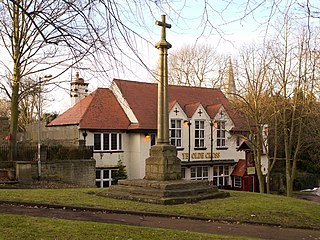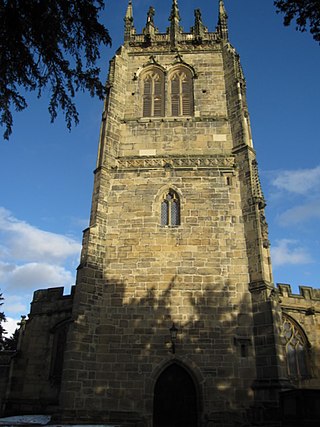
North East England is one of nine official regions of England at the first level of ITL for statistical purposes. It has three administrative levels below regional level: combined authorities, unitary authorities or metropolitan boroughs, and civil parishes. There are also multiple divisions without administrative functions; ceremonial counties, emergency services, built-up areas and historic counties. The largest settlements in the region are Newcastle upon Tyne, Middlesbrough, Sunderland, Gateshead, Darlington, Hartlepool and Durham.

Rothwell is a town in the south-east of the City of Leeds metropolitan borough in West Yorkshire, England, situated between Leeds and Wakefield. It is located in the eponymous Rothwell ward of Leeds City Council and Elmet and Rothwell parliamentary constituency, and is part of the West Yorkshire Urban Area.

Pleasley is a village and civil parish with parts in both Derbyshire and Nottinghamshire. It lies between Chesterfield and Mansfield, 5 miles (8 km) south east of Bolsover, Derbyshire, England and 2.5 miles (4 km) north west of Mansfield, Nottinghamshire. The River Meden, which forms the county boundary in this area, runs through the village.

Cramlington is a town and civil parish in Northumberland. It is 6 miles north of Newcastle upon Tyne. The name suggests a probable founding by the Danes or Anglo-Saxons.

Spennymoor is a town and civil parish in County Durham, England. It is south of the River Wear and is 7 mi (11 km) south of Durham. The civil parish includes the villages of Kirk Merrington, Middlestone Moor, Byers Green and Tudhoe. In 2011 the parish had a population of 19,816.

Hucknall, formerly Hucknall Torkard, is a market town in the Ashfield district of Nottinghamshire, England. It lies 7 miles (11 km) north of Nottingham, 7 miles (11 km) southeast of Kirkby-in-Ashfield, 9 miles (14 km) from Mansfield and 10 miles (16 km) south of Sutton-in-Ashfield. It is the second-largest town in the Ashfield district after Sutton-in-Ashfield.

Ferryhill is a town and civil parish in County Durham, England, with an estimated population in 2018 of 9,362. The town grew in the 1900s around the coal mining industry. The last mine officially closed in 1968. It is located between the towns of Bishop Auckland, Newton Aycliffe, Sedgefield, Shildon, Spennymoor and the cathedral city of Durham.

Middleton is a largely residential suburb of Leeds in West Yorkshire, England and historically a village in the West Riding of Yorkshire. It is situated on a hill 4 miles (6 km) south of Leeds city centre and 165 miles (266 km) north north-west of London.

Craghead is a village and former civil parish, now in the parish of Stanley, in the County Durham district, in the ceremonial county of Durham, England. It is a mining village. It is located at the bottom of the valley to the south of Stanley, on the main road between Stanley and Durham, and not far from the village of Edmondsley. In 1931 the parish had a population of 4973. from 1869 Craghead was a civil parish in its own right, on 1 April 1937 the parish was abolished and merged with Stanley and Lanchester.
Chilton is a town in County Durham, England. It is situated a few miles to the east of Bishop Auckland and a short distance to the south of Ferryhill, on the A167.

Shotton Colliery is a village in County Durham, England.

Standish is a town in the Metropolitan Borough of Wigan, Greater Manchester, England. Within the boundaries of the historic county of Lancashire, it is on the A49 road between Chorley and Wigan, near Junction 27 of the M6 motorway. The population of the town was 13,278 in the 2011 census.

Whitburn is a village in South Tyneside, in the metropolitan county of Tyne and Wear on the coast of North East England. It is located 3 miles (4.8 km) north of the city of Sunderland and 4 miles (6.4 km) south of the town of South Shields. Historically, Whitburn is part of County Durham. Other nearby population centres include Seaburn, Cleadon and Marsden. The village lies on a south-facing slope, part of Durham's Magnesian Limestone plateau, which overlooks Sunderland. The population for the combined Whitburn and Marsden Ward in the 2011 UK Census was 7,448. For much of its history, Whitburn was a fishing and agricultural community. The village contains three schools, three churches, a cricket club, recreational grounds, a pub and a variety of shops.

Ryton is a village in Tyne and Wear, England. It is in the Metropolitan Borough of Gateshead, historically part of County Durham. In 2011, the population of the Ryton, Crookhill and Stella ward was 8,146. It is 6 miles (9.7 km) west of Newcastle upon Tyne.

Gresford is a village and community in Wrexham County Borough, Wales.

Bishop Sutton is a village on the northern slopes of the Mendip Hills, within the affluent Chew Valley in Somerset. It lies east of Chew Valley Lake and north east of the Mendip Hills, approximately ten miles south of Bristol on the A368, Weston-super-Mare to Bath road. Bishop Sutton and the neighbouring village of Stowey form the civil parish of Stowey Sutton.

The River Skerne is a tributary of the River Tees. It flows through County Durham in England.

Mary Ann Cotton was an English convicted murderess who was executed for poisoning her stepson. Despite her sole conviction for murder, she is believed to have been a serial killer who killed many others including 11 of her 13 children and three of her four husbands for their life insurance policies. Her preferred method of killing was poisoning with arsenic.
Fishburn is a village and civil parish in County Durham, England.
Mainsforth Colliery was situated between Ferryhill and the small hamlet of Mainsforth in County Durham, England, United Kingdom. It was adjacent to the former Ferryhill railway station in the Ferryhill Station area of the town.


















